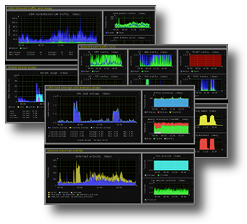Nagios Core, formerly known as Nagios, is a free and open-source computer-software application that monitors systems, networks and infrastructure. Nagios offers monitoring and alerting services for servers, switches, applications and services. It alerts users when things go wrong and alerts them a second time when the problem has been resolved.

The Multi Router Traffic Grapher (MRTG) is free software for monitoring and measuring the traffic load on network links. It allows the user to see traffic load on a network over time in graphical form.
In computing, syslog is a standard for message logging. It allows separation of the software that generates messages, the system that stores them, and the software that reports and analyzes them. Each message is labeled with a facility code, indicating the type of system generating the message, and is assigned a severity level.
In computing, a solution stack or software stack is a set of software subsystems or components needed to create a complete platform such that no additional software is needed to support applications. Applications are said to "run on" or "run on top of" the resulting platform.

LAMP is an acronym denoting one of the most common software stacks for many of the web's most popular applications. However, LAMP now refers to a generic software stack model and its components are largely interchangeable.
A software repository, or repo for short, is a storage location for software packages. Often a table of contents is also stored, along with metadata. A software repository is typically managed by source control or repository managers. Package managers allow automatically installing and updating repositories.
syslog-ng is a free and open-source implementation of the syslog protocol for Unix and Unix-like systems. It extends the original syslogd model with content-based filtering, rich filtering capabilities, flexible configuration options and adds important features to syslog, like using TCP for transport. As of today, syslog-ng is developed by Balabit IT Security Ltd. It has three editions with a common codebase. The first is called syslog-ng Open Source Edition (OSE) with the license LGPL. The second is called Premium Edition (PE) and has additional plugins (modules) under a proprietary license. The third is called Storebox (SSB), which comes as an appliance with a Web-based UI as well as additional features including ultra-fast-text search, unified search, content-based alerting and a premier tier support.
The following tables compare general and technical information for a number of notable network monitoring systems. Please see the individual products' articles for further information.
Rsyslog is an open-source software utility used on UNIX and Unix-like computer systems for forwarding log messages in an IP network. It implements the basic syslog protocol, extends it with content-based filtering, rich filtering capabilities, queued operations to handle offline outputs, support for different module outputs, flexible configuration options and adds features such as using TCP for transport.

LYME and LYCE are software stacks composed entirely of free and open-source software to build high-availability heavy duty dynamic web pages. The stacks are composed of:
SNMPTT is an SNMP trap handler written in Perl for use with the NET-SNMP/UCD-SNMP snmptrapd program. Received traps are translated into user friendly messages using variable substitution. Output can be to STDOUT, text log file, syslog, NT Event Log, MySQL (Linux/Windows), PostgreSQL, or an ODBC database. User defined programs can also be executed.

Shinken is an open source computer system and network monitoring software application compatible with Nagios. It watches hosts and services, gathers performance data and alerts users when error conditions occur and again when the conditions clear.

Extromatica Network Monitor is a network monitoring application created and maintained by Extromatica company. It is designed to monitor network hardware, servers and network services for faults and performance degradation. It alerts users when things go wrong and again when they get better. The software supports a variety of real-time notification mechanisms, including Short Message Service (SMS).

Icinga is an open-source computer system and network monitoring application. It was originally created as a fork of the Nagios system monitoring application in 2009.

Monitorix is a computer network monitoring tool that periodically collects system data and uses the web interface to show the information as graphs. Monitorix allows monitoring of overall system performance, and can help detect bottlenecks, failures, unusually long response times and other anomalies.
Mojolicious is a real-time web application framework, written by Sebastian Riedel, creator of the web application framework Catalyst. Licensed as free software under the Artistic License v 2.0, it is written in the Perl programming language, and is designed for use in both simple and complex web applications, based on Riedel's previous experience developing Catalyst. Documentation for the framework was partly funded by a grant from The Perl Foundation.
The following outline is provided as an overview of and topical guide to the Perl programming language:
Checkmk is software developed in Python and C++ for IT Infrastructure monitoring. It is used for the monitoring of servers, applications, networks, cloud infrastructures, containers, storage, databases and environment sensors.
Rainer Gerhards is a German software engineer, network engineer, and protocol designer best known for his Computer data logging work including Rsyslog and Reliable Event Logging Protocol. He began developing Rsyslog in 2004, to forward log messages in an Internet Protocol Network from UNIX and Unix-like computer systems. In 1988, Gerhards founded the company RG Informationssysteme, which was later rebranded as Adiscon GmbH in 1997.

NXLog is a multi-platform log collection and centralization tool that offers log processing features, including log enrichment and log forwarding. In concept NXLog is similar to syslog-ng or Rsyslog but it is not limited to UNIX and syslog only. It supports all major operating systems such as Windows, macOS, IBM AIX, etc, being compatible with many SIEM, log analytics suites and many other platforms. NXLog can handle different log sources and formats, so it can be used to implement a centralized, scalable logging system. NXLog Community Edition is proprietary and can be downloaded free of charge with no license costs or limitations.












